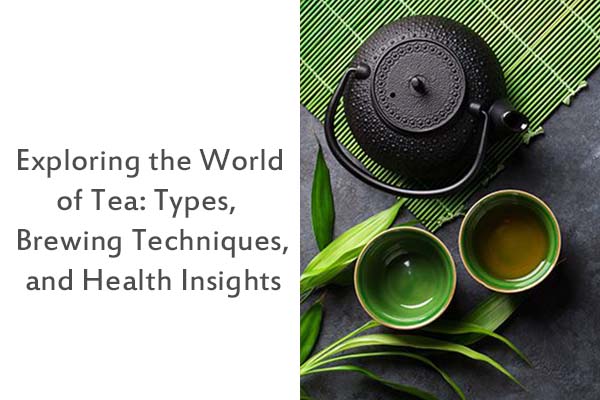Tea Types, Brewing Techniques, and Health Insights

Tea, one of the world’s oldest beverages, is revered for its various tastes and health benefits. From Darjeeling’s rolling hills to Kenya’s highlands, tea tells a story in every cup. But what makes each type unique, and how can brewing techniques enhance your tea experience? Let’s steep ourselves in the world of tea, exploring its diversity, the art of brewing, and the science-backed health benefits that make it a global staple. Tea is not just a beverage, it’s a cultural symbol too. It has been a part of various traditions and ceremonies around the world for centuries. From the Japanese tea ceremony to the British afternoon tea, it has played a significant role in shaping the social fabric of many societies. So next time you sip on a cup of tea, remember that you’re not just drinking a beverage, but a piece of history and culture.
It is recommended that you visit the page related to the saffron price
The Diversity of Tea: Understanding Types Tea can be broadly categorised into black, green, white, oolong, and herbal teas, each with its distinct processing method and flavour profile.
- Black Tea: Fully oxidised for a robust flavour, black tea is known for its heart health benefits. A study in the American Journal of Clinical Nutrition suggested that regular consumption of black tea could reduce blood pressure.
- Green Tea: Minimally oxidised, green tea retains a higher content of antioxidants, particularly epigallocatechin gallate (EGCG). Research in the Journal of the American Medical Association found that green tea consumption reduces mortality due to all causes, including cardiovascular disease.
- White Tea: The least processed, white tea is prized for its delicate flavour and high antioxidant levels. A study published in Nutrition and Metabolism highlighted white tea’s potential in reducing the risk of chronic diseases like cancer.
- Oolong Tea: Partially oxidised, oolong tea balances green and black tea, with studies indicating its effectiveness in weight management.
- Herbal Teas: Made from herbs, fruits, seeds, or roots, herbal teas (like chamomile, peppermint, and hibiscus) are caffeine-free and traditionally used for various health benefits, from improving sleep to aiding digestion.
The Art of Brewing Perfect Tea Brewing tea is a ritual that varies across cultures. The ISO 3103 standard provides a guideline for brewing black tea, emphasising the importance of water temperature and steeping time in extracting tea leaves’ full flavour and health benefits.
- Water Temperature: Green and white teas require cooler water (around 70-80°C) to prevent bitterness, while black and oolong teas are best brewed with water at near-boiling temperatures (90-100°C).
- Steeping Time: Delicate teas like green and white should steep for 1-3 minutes, whereas black and oolong teas can be soaked for 3-5 minutes for optimal flavour.
In addition to the guidelines provided by the ISO 3103 standard, there are other factors to consider when brewing the perfect cup of tea. For instance, the type and quality of tea leaves, the type of water used, and the vessel used for brewing can all impact the final product. Some tea enthusiasts also recommend pre-warming the teapot and cups before brewing, to ensure that the tea stays hot for longer. Experimenting with different brewing methods and techniques can be a fun and rewarding way to discover new flavours and aromas. Whether you prefer a strong, bold cup of black tea or a delicate, floral cup of green tea, there’s no right or wrong way to brew the perfect cup – it all depends on your personal taste preferences!
Health Benefits of Tea: A Cup of Wellness Tea’s health benefits are vast, with numerous studies supporting its role in promoting well-being.
- Cardiovascular Health: Regular tea consumption has been linked to a lower risk of heart disease, attributed to antioxidants that improve heart health.
- Cognitive Function: A study in the Journal of Nutrition, Health & Aging found that daily tea consumption can improve brain efficiency, potentially reducing the risk of cognitive decline.
- Weight Management: Certain teas, especially green tea, have been shown to aid in weight loss by enhancing metabolic rate.
- Antioxidant Properties: Tea is rich in antioxidants, which help combat oxidative stress and may reduce the risk of chronic diseases.
Tea is known to be rich in antioxidants, which help to protect the body against damage from free radicals. It also contains compounds that can reduce inflammation, boost the immune system, and promote healthy digestion. Some studies have even suggested that regular tea consumption may help to reduce the risk of chronic diseases such as heart disease, stroke, and certain types of cancer. Additionally, tea can be a great source of hydration without the added sugars and calories found in many other drinks. With so many potential health benefits, it’s no wonder that tea has become such a popular beverage around the world.
Conclusion: Tea offers more than just warmth and comfort; it’s a beverage steeped in history, culture, and health benefits. Whether you’re a devotee of black tea or a green tea enthusiast, understanding the types of tea, mastering the brewing techniques, and acknowledging the health benefits can elevate your tea experience. At Parsa Global Saffron and Tea, we’re committed to bringing you the finest selection, ensuring each cup you pour is a journey to wellness and delight.
In addition to its cultural and health significance, tea has also become a social activity that brings people together. Whether you’re sharing a pot of tea with friends, or simply enjoying a quiet moment alone, tea can be a source of relaxation and connection. At Parsa Global Saffron and Tea, we believe in the power of tea to create community and promote well-being. That’s why we source our teas from the highest quality farms and estates around the world, ensuring that each sip is a unique and satisfying experience. So, whether you’re a seasoned tea drinker or just starting out, we invite you to join us on a journey of discovery and delight.

 Herbal Tea Bags
Herbal Tea Bags Premium Dried Fruit
Premium Dried Fruit